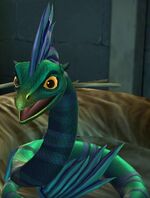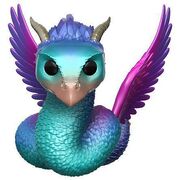
|
Warning!
At least some content in this article is derived from information featured in: Harry Potter: Hogwarts Mystery & Harry Potter: Magic Awakened & Hogwarts Legacy. |
- "The Occamy is found in the Far East and India. A plumed, two-legged winged creature with a serpentine body, the Occamy may reach a length of fifteen feet. It feeds mainly on rats and birds, though has been known to carry off monkeys. The Occamy is aggressive to all who approach it, particularly in defence of its eggs, whose shells are made of the purest, softest silver."
- — Newt Scamander, Fantastic Beasts and Where to Find Them[src]
The Occamy was a winged, serpentine magical beast native to the Far East and India.[1]
Description[]

A fully grown Occamy
It was a plumed, two-legged serpentine-bodied creature with wings that reached up to fifteen feet in height. The Occamy was extremely aggressive to anyone who approached it, and lived off of insects, rats, birds, and occasionally monkeys. It was extremely protective of its eggs, which were made of the most pure and soft silver. It was found in the Far East and India.[1]
The Occamy was known to be choranaptyxic, meaning it grew or shrank in order to fit available space.[2]
It was a known possible but rare corporeal form of the Patronus Charm.[3]
History[]

Baby Occamies in Newt Scamander's suitcase
Newton Scamander had several Occamies in his suitcase during his visit to New York in 1926. One of them escaped, along with various other creatures, and had to be eventually tracked down and captured in the storeroom of Ginzberg Delaunay, a New York department store.[4]

Squawk, an Occamy
At some point during his teaching career, the Care of Magical Creatures Professor Silvanus Kettleburn brought an Occamy to Hogwarts School of Witchcraft and Wizardry.[5] During the 1986–1987 school year, Kettleburn asked Jacob's sibling and Liz Tuttle to care for his baby Occamy Squawk while he was away, which might have been this Occamy.[6]
During the 1990–1991 school year at Hogwarts, Professor Kettleburn taught seventh-year students about the handling of Occamies in Care of Magical Creatures.[7]
It was once Gilderoy Lockhart's ambition to create a line of haircare products, as he was very proud of his naturally bouncy and wavy hair. He wanted to mass produce the products with his secret ingredient: Occamy egg, as the main ingredient for Occamy egg yolk shampoo.[8] As Occamies were very territorial, it proved to be too dangerous and too expensive to supply. It is unknown if Lockhart, a long-term resident of St Mungo's, recalled this failed aspiration.
By at least the 2010s, during the Calamity, a Calamity Investigator working for the Statute of Secrecy Task Force studied the habits and environment of Occamies and Mokes in order to determine the potential similarity between their shrinking abilities. Rolf Scamander also gave a lesson on Occamies to Magizoologist members of the task force based on his grandfather's research.[9]
Etymology[]
The word "Occamy" is derived from the name of the English philosopher Occam, who invented the methodological principle "Occam's Razor", which asserts that when evaluating two competing explanations for a situation one should accept the one that requires least assumptions to be made (or, in other words, nothing should be presumed to exist that is not absolutely necessary for explanation).
As such, the naming of this creature as an "Occamy" is a joke on the part of J. K. Rowling, since the existence of the Occamy itself (and just about every other creature described in Fantastic Beasts and Where to Find Them) has no reason to exist and came into being solely for the sake of fleshing out the aforementioned book.[10] 'Occamy' is also an archaic term, derived from 'alchemy', for counterfeit silver, hence the silver eggs.[citation needed]
Behind the scenes[]

An Occamy as a POP! Vinyl (rare)
- It is currently unknown if Occamies, given their snake-like appearance, can speak Parseltongue.
- While some art depicts them as bipedal bird-like creatures, the film showed them as long and serpentine.
- The film version of the Occamy resembles Kukulkan, a mythological god from Mexico and Guatemala, who had the appearance of a winged serpent. Often confused with Quetzalcoatl, they are not the same, as Quetzalcoatl had no wings.
- Occamies resemble Amphipteres from European Heraldry, and were described as serpentine creatures with either fully feathered bodies and wings or scaled bodies with semi-feathered wings.
Media[]
Appearances[]
- Fantastic Beasts and Where to Find Them (First appearance)
- Fantastic Beasts and Where to Find Them: The Original Screenplay
- Fantastic Beasts and Where to Find Them (film)
- Fantastic Beasts: The Crimes of Grindelwald
- Pottermore
- Harry Potter (website)
- LEGO Dimensions
- LEGO Harry Potter
- Wonderbook: Book of Spells
- Wonderbook: Book of Potions
- Fantastic Beasts: Cases from the Wizarding World
- Harry Potter: Hogwarts Mystery
- Harry Potter: Wizards Unite
- Harry Potter: Magic Awakened
- Hogwarts Legacy (Mentioned only)
Notes and references[]
- ↑ 1.00 1.01 1.02 1.03 1.04 1.05 1.06 1.07 1.08 1.09 1.10 1.11 1.12 1.13 1.14 1.15 Fantastic Beasts and Where to Find Them
- ↑ "'Fantastic Beasts': Meet the Creatures" at Entertainment Weekly
- ↑ (see this image)
- ↑ Fantastic Beasts and Where to Find Them: The Original Screenplay
- ↑ Happy Birthday Silvanus Kettleburndead link
- ↑ Harry Potter: Hogwarts Mystery, Year 3, "A BAD OMEN" Achievement
- ↑ Harry Potter: Hogwarts Mystery, Year 7, Chapter 18 (Long Live the Doxy Queen) - Care of Magical Creatures Lesson "Occamy"
- ↑ "J.K. Rowling comments on Lockhart's hair, Hogwarts House, mother via Pottermore" at SnitchSeeker.com
- ↑ Harry Potter: Wizards Unite
- ↑ Court record of the legal dispute between JK Rowling and the HP Lexicon over the proposed publication by the latter of an unofficial and unauthorised Harry Potter guide
| Care of Magical Creatures | |
|---|---|
| Care of Magical Creatures at Hogwarts | |
| Hagrid's Hut · Forbidden Forest · Care of Magical Creatures Classroom · Magical Creatures (club) · The Paddock | |
| Professors | Silvanus Kettleburn · Rubeus Hagrid · Wilhelmina Grubbly-Plank (substitute teacher) |
| Textbooks | The Monster Book of Monsters · Fantastic Beasts and Where to Find Them |
| Creatures studied at Hogwarts | |
| Blast-Ended Skrewt · Bowtruckle · Chimaera · Crup · Demiguise · Diricawl · Doxy · Dugbog · Fairy · Fire Crab · Fire Dwelling Salamander · Flobberworm · Fwooper · Glumbumble · Gnome · Golden Snidget · Griffin · Hippogriff · Imp · Jackalope · Knarl · Kneazle · Moke · Murtlap · Niffler · Occamy · Porlock · Quintaped · Streeler · Thestral · Unicorn · Yeti | |
| Magical creatures by classification | |
|---|---|
| X | Flobberworm · Horklump |
| XX | Augurey · Bowtruckle · Chizpurfle · Clabbert · Diricawl · Fairy · Ghoul · Gnome · Grindylow · Imp · Jobberknoll · Mooncalf · Porlock · Puffskein · Ramora · Winged horse |
| XXX | Ashwinder · Billywig · Bundimun · Crup · Doxy · Dugbog · Fire crab · Fwooper · Glumbumble · Hippocampus · Hippogriff · Hodag · Jarvey · Knarl · Kneazle · Leprechaun · Lobalug · Mackled Malaclaw · Moke · Murtlap · Niffler · Nogtail · Pixie · Plimpy · Pogrebin · Red Cap · Salamander · Sea serpent · Shrake · Streeler · Winged horse |
| XXXX | Centaur · Demiguise · Erkling · Erumpent · Golden Snidget · Graphorn · Griffin · Hidebehind · Kappa · Kelpie · Merperson · Occamy · Phoenix · Re'em · Runespoor · Snallygaster · Sphinx · Tebo · Thestral · Thunderbird · Troll · Unicorn · Winged horse · Yeti |
| XXXXX | Acromantula · Basilisk · Chimaera · Dragon · Horned Serpent · Lethifold · Manticore · Nundu · Quintaped · Wampus cat · Werewolf |


